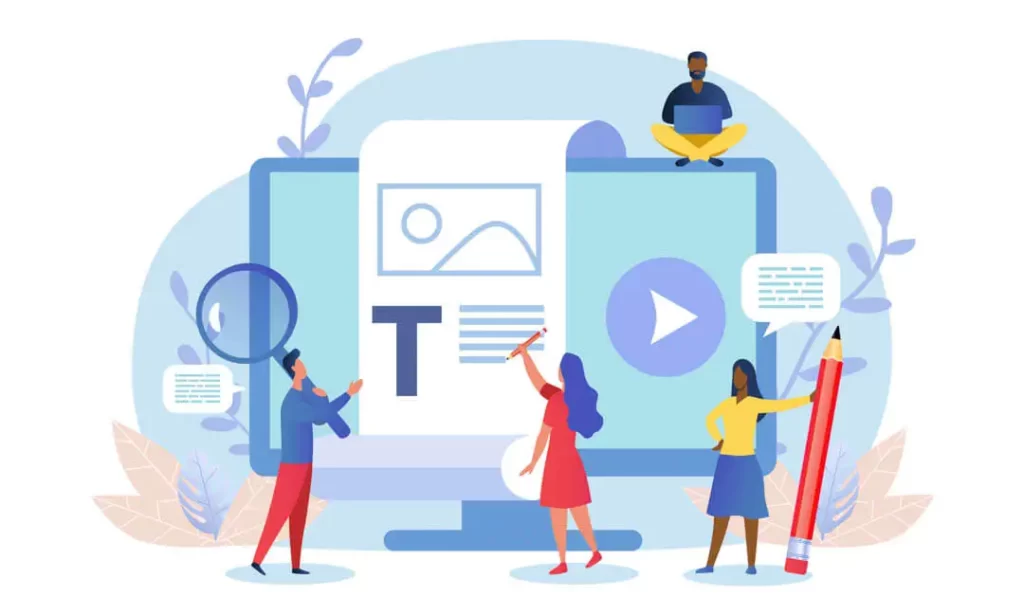Objective: create engaging, educative, and optimized copy (that’s the juice if you want to know how to write like a copywriter)
Why: to increase readability, share-ability, and conversions
Procedure: Once you know the topic and keywords to use, you follow the following 5 steps.
Before I start presenting my 5 copywriting steps, it’s important to note that you need a certain sense of discipline, experience, and art to create compelling content. So, feel free to contact me if you want a professional to write your article or blog for you. I offer copywriting services in the English language and the creation/design of websites in English and Greek.
SUMMARY:
Writing starts with research. Although you may have already done your topic and keyword research, there is more to do. So, the first step is to research the online content for the target/main keyword and collect information in a file. The next step is to organize the content you have collected.
It is finally time to start writing your original content. Once you have created your first draft, step 4 is to edit your work. This is the second most crucial step in the writing phase after research. Last, you will further optimize your content for search engines.

Step 1: RESEARCH ONLINE CONTENT
Why: The more time you research, the better your writing
How to Write Like a Copywriter: Start with making questions based on the keyword research you have done.
- Check Quora for inspiration, and create questions that challenge your assumptions. Google the questions.
Google the target keyword (or secondary keywords if necessary)
- skim through the results. Then, select at least 5 pages that concern your keyword and open each in a new tab.
Read the headlines and highlighted sentences for each article.
- How they’ve structured their content? What angle are they taking?
Read the content.
- Take your time and take notes of any gaps or useful information.
- Whenever you find something you want to include in your writing, you copy and paste the text into a file.
Find Data & Numbers
- To find data and research articles, Google the topic together with any of the keywords: psychology, science, sociology, data, expert, research, scientific.
- If needed, repeat the above process in third resources and search engines: Boardreader, DuckDuckGo, Yippy, The WWW Virtual Library, Vimeo, Google Trends, Google Scholar, Google Books, Google Public Data, The Internet Archive, http://socialmention.com, Twitter, Archive.org, Google Books, Library Of Congress, The National Archives.
How to Write Like a Copywriter: Find and Match Search Intent for the focus keyword.
- What is the question that the target audience asks?
- What are the target audience’s biggest desires, problems, and difficulties?
- What do they want to read? Are they looking for information, a specific webpage, or a product/service? —> check the results from the Google search to get a direct insight into what people are looking for when they type in the keyword
- The more similar the pages in the search results, the more clear the search intent. Check which type of intent is most common. Your content needs to give someone searching for your keyword what they want.
- How do they feel? What forced them to search for this content?
- Where does your target audience look for information online? Who do they trust? What draws their attention negatively?
- How can you provide real benefits/value to them? What do they want to gain from the content?

Step 2: ORGANIZE CONTENT
How to Write Like a Copywriter: Know your article’s end goal
- What is the purpose of the article? Are you hoping to inform, educate, promote a product or service, solve a problem, or answer a question? Tip: focus on a single purpose that aligns with the search intent
- What do you want to achieve? Are you hoping to get more website traffic and ranking keywords? Or do you want readers to take an action? (Subscribe, buy, etc.)
- How does this blog meet a need or address a pain point for your readers? Give them an easy win (your content should help your audience achieve something)
Decide on the post template (What structure will best frame your content?)
| Expanded List Post | Give lots of detail about each item on your list |
| Branded Strategy | solve a problem that your target audience struggles with & give the solution a “branded” name |
| complete Lists | a hand-picked list of the best tools you recommend – something that helps your reader solve a problem. Odd numbers work the best |
| an Ultimate Guide (how-to-post) | a complete resource that covers everything |
| a FAQ page | it helps with Voice search optimization as well |
| Case studies | Research case studies from top blogs in your niche. Tell a story using real people and examples. Explain the solution step-by-step with the problem, solution, and outcome. |
| Content transformation | eg, from writing to video |
| content Hubs | A bunch of related content that covers a specific topic: present this content as entries in a single “hub”. |
| Research content | Use Data. Find a helpful, big idea on something that is never covered |
| Visual Content | (especially “Concept Visuals”) —> Use images that are easy for other sites to embed into their content |
| Reoptimize old content for Search Intent | Create content that’s a 1:1 Search Intent Match |
| Long-form content | expect long-form content to work even better for SEO in 2021 |
| Your own success stories | Connect the dots between your own challenges and the problems your audience faces every day. Write an open, honest, and transparent post about how you’re overcoming that challenge to reach your goals. |
| Present a new solution to an old problem. | Find the unique angle you used to solve a problem, a method that’s working for you, has already solved your problem, and something different that no one has covered before. Convert it into a step-by-step solution. |
| Infographics | Find the big ideas in your infographic, and figure out how you’ll draw attention to specific elements. Remove the clutter to provide focus. Practice the five fundamentals of good design: consistency, repetition, alignment, hierarchy, and proximity |
| Guest post | Identify the blog to guest post on that is a good fit for what you generally want to talk about and what your audience will really care about. Pitch your best three ideas and also write a small summary of why they’ll be successful. |
How to Write Like a Copywriter: Create an Outline
- What ideas and angles will you cover for your topic?
- Take the questions/topics from your keyword research and lay them out in a logical order
- At a minimum, outline your headings and subheadings so you have a logical plan when you start writing.
- Prepare to write comprehensive content. Google wants to show their users content that gives them EVERYTHING they want on a single page
- Place all the references (links) you have found already in your outline. Also, include 4-5 internal links as well.
- Always write content that brings something new to the table. Make your SEO content insanely valuable (Add details, updated material)
- Include specific, actionable tips. Readers should always learn something valuable
- Have a subheading every 300 words
Decide on Presentation Method
Inverted Triangle (ideal for research posts)
- 1. show your reader why this matters to them (most newsworthy info)
- 2. tell them what your end results were (important details)
- 3. share the research, interpreting and showing readers how it applies to their life (other background info)
- 4. conclude again
PAS (Problem, Agitate, Solve)
- (Opening hook) Identify a Problem (based on the research) —> Paint the picture, make an intriguing question
- (information section) Agitate anxiety around the problem (the reaction): what makes this problem particularly pressing? Why does it happen? —> key fundamentals, relevant examples
- (How to section) Offer a solution: how can your product or service make your audience’s life better —> Breakdown and highlight the core benefits of your solution. Combine your solution with actionable steps.
AIDA (Attention, Interest, Desire, Action)
- Capture readers’ attention (e.g., with an intriguing headline)
- Stoke interest: follow on with interesting info that keeps the audience reading to your call to action
- Inspire desire: Show your reader how life could be better with your product or service
- Drive action: Roll out your call-to-action and tell them how they can learn more
The Four C’s (Clear, Concise, Compelling, Credible)
- Clear: make your point plain as day
- Concise: cut anything from your content that doesn’t directly help your reader
- Compelling: make it interesting. Work in stats and other data points that are accurate but hard to believe
- Credible: back up your claims with reputable sources
The 9-step approach (by coschedule)
| 1.Headline | The goal is to Grab Attention | |
| 2.Opening | Key insight | Clearly communicate that you understand your readers’ problem and have the answer to it. Establish yourself as the authority on the topic and set clear expectations by sharing what’s covered in the |
| 3.Table of content | If >1500 words | Keep your table of content above the fold so visitors can see it without having to scroll |
| 4.Sub Head | Big Promise | entice people to read your first piece of content by giving them a benefit |
| 5.Content | Connect Emotionally | Aim to trigger an emotion in your reader. |
| 6.CTA-1 | The SoundBite | Use click to tweet “quote” or anything of interest |
| 7.Sub head | The Big Promise | Here is what you promised. |
| 8.Content | The How-To section | Give practical, easy-to-implement advice. Get people results, and they will remember you forever. |
| 9.CTA-2 | Buy or Subscribe | Another call to action |
Prepare for Featured Snippets
- Find Featured Snipper opportunities —> keyword research (focus on keywords that you already rank for -at least on page 1- and keywords that have a featured snippet)—> Ahrefs “Organic Keywords” report.
- Add “Snippet Bait” to your Page (40-60 words)
- Format your content for other types of Featured Snippets (apart from paragraphs: lists, tables). If you want to rank for list snippets, use H2 or H3 subheaders for every item on your list. Similarly, create well-formatted tables for table snippets.

Step 3: WRITE CONTENT
Use the keywords
- Next to your text editor, have visible a list with all keywords you want to use. It should be the main and secondary keywords you have selected from KEYWORD RESEARCH.
- Use focus keyword in URL, title tag, first 100 words of page, in an H1 tag, in an H2 tag.
- Mention your target keyword a few times (eg, more than 5) to confirm to Google that your page really is about that topic.
How to Write Like a Copywriter: Choose your Writing style
- Write like you talk. Even better, write like the reader talks (Read out loud your content to make sure it is conversational tone)
- Use Active Voice (avoid passive voice)
- Cut the fluff (eg, never repeat something, every sentence must provide value to the reader)
- Use Short Paragraphs (1-3 sentences long), and short sentences (up to 24 words long), but also include a few mid-size sentences to spice things up
- use power words: for the first time in the world, make you, no questions asked, pay zero, things I’ve ever seen, what this, will make you, you see what, you need to know, you see, what happened to
How to Write Like a Copywriter: Engage the reader
- Appeal to the mind —> present rock-solid, useful content in a way that’s easy to read and absorb
- hook your reader —> an alarming statistic, a theme or story that hits home with readers in a very personal way, describe a moving situation from an emoticon perspective, your style of writing
- convey your enthusiasm —> choose to write about topics you are genuinely interested in OR select a specific angle to a certain topic
- Tell a story that touches on common human experiences and emotions —> effort on character development, use a conversational tone, use action words, describe experiences, and express sympathy with the character
- Make an emotional connection —> Use loaded language , figurative language, a pinch of humor, and descriptive language
- Share benefits rather than features —> focus on readers’ needs and pain points
- Ask engaging questions
- Use “you”; prefer “we” over “I”.
- Use Varied sentence length, along with varied sentence structure (syntax).
Write the Intro
How to Write Like a Copywriter: The goal is to grab the reader’s attention
- Jump straight into the content promised
- Focus on the problem: tell a story, ask a rhetorical question, or use a metaphor.
- Show the value to your reader.
- Start with an interesting fact, story, anecdote, end of a story, cliffhanger, or question (eg, What if you never had to worry about {something} ever again?)
Use 4-7 sentences (3 to 5 paragraphs)
Use the PPP formula (or PPB)
- Preview: let your reader know EXACTLY what to expect “In this post, I’m going to show you how to get more views on YouTube.”
- Proof: prove that you know your stuff (use Personal results, years of experience, number of clients, credentials, or certifications) and that you understand their problem
- Preview: Get specific about something from your post. End your intros with a transition sentence (eg “Let’s dive right in”)
- -Keep reading
-Let’s get started
-It’s time for the first step
-Let’s dive right in
-Now it’s time to show you what happened
-Let’s kick things off with strategy #1
- -Keep reading
How to Write Like a Copywriter: Use empathy
- Start with the exact problem the readers want to solve
- Promise to deliver a solution
- Make the problem relatable (drop the reader into a relatable scenario)
- Include a template or a summary of essential points or conclusions
Use or plan for aids
- Create Subheadings (ideally every 300 words or less)
- Create high-impact blockquotes bulleted Lists (avoid too much text between bullets)
- Use as many Visuals as you can —> whenever it makes sense, use custom graphics, screenshots, and charts. Ideally, one visual element per 300 words
- Provide proof for what you say: testimonials, case studies, real-world examples, success stories, or even embedded tweets from your audience that praise your work/product.
- Use Data —> databases to find data and make sure you present the data in bite-sized chunks (make it easy for them)
- Google Scholar
- SimilarWeb
- Data.gov
- Crunchbase
- Wikipedia
- Statista
- Tools and Software (like the Google Keyword Planner)
- Add a quick video
- Add content upgrades (additional downloadable resources that add value to your post: Free Word or Excel templates, infographics, ebooks, white papers, research reports)
How to Write Like a Copywriter: Choose words carefully
Place Calls to action when they are easy to see
Use power words
- you
- free, save, gift, “money-back”, “100% satisfaction”, “no questions asked”, “full refund”, “no risk”, “limited time”, exclusive, bonus, improvement, challenge
- guarantee, easy, proven, real, solution, results, simple, eliminate, rid, wipe out, blast away, defeat, soothe, melt away, evaporate, fight
- discover, learn, click, amazing, incredible, shocking, remarkable, latest, surprising, power
- know, try, how, how to, best, top, hot, powerful, XX ways
- secret, breakthrough, revolutionary, sensational, remarkable, revelations, miracles, imagine, announcing, inspire
- boost, create, increase, promote, build, protect, help, improve
- today, before midnight, now, right now, tell us, hurry, join, become a member, donate
Use Transition words/phrases:
- Sum: Above all, All things considered, Arguably, Finally, Accordingly, By and large, Therefore, Ultimately
- emphasis: Instantly, Immediately, Actually, As a matter of fact, At this point, Even so, For example, In any case, In fact, In other words, No doubt
- similar: At any rate, At the same time, By the same token, In the first place, In the same way, Of course, Similarly, Presently, Be that as it may
- result: As a consequence, As a result, Consequently, For this reason, In conclusion, From here on
- add: What’s more, Moreover, Plus, As a bonus, but that’s not all, First, Second, Third, Afterward, Another, Furthermore, In addition, Next, Then, too, also
- opposite: However, In the meantime, Meanwhile, Ironically, On the other hand, Otherwise, Paradoxically, Regrettably, Still, Strangely enough
Write Conclusion: provide actionable content (take away)
- Make sure to resolve the problem and summarize what you said
- Transition (eg, “Now I’d like to hear from you)
- Ask: something specific that’s easy to answer (not something general). Pick one next-step action, but not all of them.
- Make a clear, specific, strong Call to Action: “Either way, let me know by leaving a comment below right now”, “Share with your network”, “Sign up for email newsletters.”
- Make it ridiculously easy for your audience to act on your content.
- How to Write Like a Copywriter: You need to tell your reader exactly what to do, how to do it, and that you want her to do it right now.
Write Headline
- (remember: the deadline determines whether the audience will read the rest of your work; it needs to convince a reader that the rest of your article is worth their time)
How to Write Like a Copywriter: write something intriguing and catchy (interesting/emotional) that will entice people to click through to your site.
- (Don’t just stuff keywords.)
- Ideally, write at least 25 headlines and choose the best
- Communicate a clear Benefit for them. Focus your headlines on helping instead of telling.
- Suggest the best way to do something / Give advice for improvement / Provide Solid Evidence to Support a Claim / Share your experience / State a Problem and offer a solution
- Use Emotion —> measure your EMV score using this tool from the Advanced Marketing Institute (try to get at least 25%)
- can analyze titles using Headline Analyzer Studio
Pay attention to the words
- Contain instructional phrases like “you need to know” or “why you should”
- Use power words: proven, ridiculously simple, easy, free, boost, reward.
- Include an action word
- Include words that reference additional content (eg, an infographic)
- Go extremely positive or negative: “best, always, fastest, easiest, most, greatest, largest, funniest, hottest, strongest, biggest, ever, perfect, top” vs. “never, worst, nothing, no one, no way, by no means, nope, stop, avoid, don’t.”
Be stingy about what to include.
- Use 6-7 words, ideally, no more than 16. Between 60 to 80 characters
- title tag: the closer the keyword is to the beginning of the title tag, the more weight it has with search engines.
- Use title tag modifiers: “best”, “guide”, “checklist”, “fast” and “review”
- Use a specific number (eg, current year)
- Add Brackets (And Parentheses): eg, at the end of the headline, such as “(2021 update)”
How to Write Like a Copywriter: Pay attention to the appearances
- Capitalize the first letter of every word
How to start your headline:
| X reasons why… | X of the… | These are the… | X things to… |
| X things you… | X ways to… | Here are the… | You can now… |
| This is what… | This is why… | How to get… | The X most… |
| This is the… | The X best… | X stunning photos… | X things only… |
| This is how… | How to make… | X things that… | Why you should… |
- If B2B, use phrases such as:
| the future of… | X things you… | why you should… | of the future… |
| X ways to… | one of the… | that will transform… | X tips for… |
| need to know… | the power of… | the top X… | you want to… |
| in the world… | how to get… | want to be… | the X most… |
| of the year… | how to make… | in X years… | the end of… |
- Use specific phrases such as
| will make you | tears of joy | stocked to see |
| this is why | is what happens | melt your heart |
| can we guess | make you cry | X things only |
| only X in | give you cry | can’t stop laughing |
| the reason is | give you goosebumps | top X songs |
| are freaking out | is too cute | Twitter reacts too |
| X stunning photos | talking about it | what happened next |
- How to Write Like a Copywriter: After the headline, make sure the first sentence creates a hook that grabs the audience’s attention (you have 3 seconds to keep readers hooked after the headline)

Step 4: EDITING
Why: there is always considerable room for improvement after the first draft
Use Grammarly
- Gramarly is one of the best applications for proofreading and editing your documents. It still requires your supervision but speeds up the process by highlighting your possible errors and areas for improvement.
How to Write Like a Copywriter: Proofread again and again
- Read out-loud
- Read backwards
- Read from different perspectives:
- As a “friend” —> to highlight the piece’s personality and remove stiff or forced-sounding language
- As a “stranger” who only wants to get value from the article—> uncover areas where the piece can be clearer or more specific
- As an “enemy” —> to excise weak arguments and anticipate objections
- When necessary, break long paragraphs into smaller ones for better readability.
Double-check the main keyword
- make sure it is on the article headline (page title), which should be clear and should convene an action/benefit
- make sure it is on the URL slug
- make sure it is in the first paragraph of the article
- make sure it is on the article subheadings
- make sure it naturally appears multiple times throughout your content
Make sure you are on point
- Does the content match the search intent and user’s needs?
- Does your content provide real value? Does it help your audience’s real-life concerns and relationships?
- Does the article convey the point you wanted to make? Does it serve your goal? Is the main point clear?
- Does it have a clear call to action for the reader? Does it stay on topic?
- Does the content serve your keyword targeting?
- Don’t be afraid to ask for feedback from others or enlist professional help to ensure you’re publishing the highest quality article possible.
- Does your introduction align with the headline?
How to Write Like a Copywriter: Let your articles sit for a day or two before you return to them for a final proofread
- See how the article flows (don’t make any edits). If you find yourself losing focus, rephrase sentences and cut unnecessary words
- (having a content calendar helps to stay on track)

Step 5. OPTIMIZE CONTENT
Write a compelling title tag
- use emotion without going overboard – reduce power words)
- Use less than 70 words
- Include the keyword
- Write your title tag like [Primary Keyword – Secondary Keyword | Brand name.]
How to Write Like a Copywriter: Write a compelling Meta Description
- Make that meta description something that will make Google searchers want to click on your result.
- Tell readers you have the answer to their problem
- Incite curiosity to cheer them to take action
- Provide a clear, concise summary of the article while creating points of intrigue.
- Use less than 320 characters
- Make sure you include a call to action: tell your audience what to do
- Include main and some secondary Keywords
- Write your meta description like: “This is [content overview]. Learn how to get [specific benefit] from this [content description]
- Add the Current Year
- Use Portent’s SERP Preview Tool to test how your proposed title tag and meta description will appear in actual search results.
Pay attention to the appearance
- (why: readers first see the overall presentation of your information before they read.)
- Use fonts, formations, and visual hierarchy to invite readers to beg if consuming your content.
- Make your URLs short. Include a keyword in every URL. Use – and not _
- Push content above the fold (put your headline and introduction front-and-center)
- If you can choose a font, opt for one between 15-21px
- Make sure to keep your call to action above the fold
How to Write Like a Copywriter: SEO matters
- Wrap Your Blog Post Title in an H1 Tag
- Use a lot of h2 subheadings, bullets, and images to chuck your content so that users can skim it super fast (h3 are okay; avoid h4)
- Make sure links open in a new tab
Optimize images
- make sure images are original
- give every image on your site a descriptive filename and alt text, preferably including the focus keyword
- if it makes sense, make one image optimized around your target keyword
- always load your images at the pixel dimensions they’ll be displayed
- Pass them through TinyJpg and then through Cloudconver to convert them into Webp files, which load faster and are preferred by Google
Finally, if you want a professional to write the article or blog for you, you can contact me. I offer travel copywriting services in the English language and the creation/design of vacation rental websites in English and Greek.



0 Comments